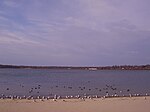On April 4, 1955, a United Airlines Douglas DC-6 named Mainliner Idaho crashed shortly after taking off from Long Island MacArthur Airport, in Ronkonkoma, Islip, New York, United States.
The flight was operated for the purpose of maintaining the currency of the instrument rating of two of the airline's pilots. Shortly after takeoff and only seconds after climbing through 150 feet (46 m), the plane began banking to the right. It continued to roll through 90 degrees; the nose then dropped suddenly and moments later it struck the ground. All three members of the flight crew were killed upon impact.
A subsequent investigation found a simulated engine failure procedure was being conducted, which involved a member of the crew pulling back the throttle lever for engine No. 4 prior to taking off. Investigators found that if the throttle lever was pulled back too far, it would cause the propeller to reverse—a feature designed to slow the aircraft upon landing. Once the landing gear was raised, the crew would have to raise a metal flag in the cockpit to bring the propeller blades back into the correct position, since a safety device prevented electric power from operating the rotating mechanism at the roots of the blades unless the aircraft was on the ground or the flag was manually raised. The Civil Aeronautics Board (CAB) concluded one of the flight crew applied full power to No. 4 engine, thinking this would bring the aircraft out of the increasing bank. Because the blades were reversed and the flag was not raised, that increased the reverse thrust from No. 4 engine, causing the DC-6 to spiral out of control. Since the plane was so close to the ground, the suddenness of the bank and dive meant the flight crew had no chance to recover the aircraft before impact.
In the aftermath of the accident, the Civil Aeronautics Administration (CAA) issued an Airworthiness Directive ordering all DC-6 and DC-6B aircraft to be fitted with a manual device which could prevent the inadvertent reversal of the propeller blades. United Airlines also stated they had begun installing reverse thrust indicator lights in the cockpits of their DC-6 aircraft, which would warn pilots when a propeller had reversed.








